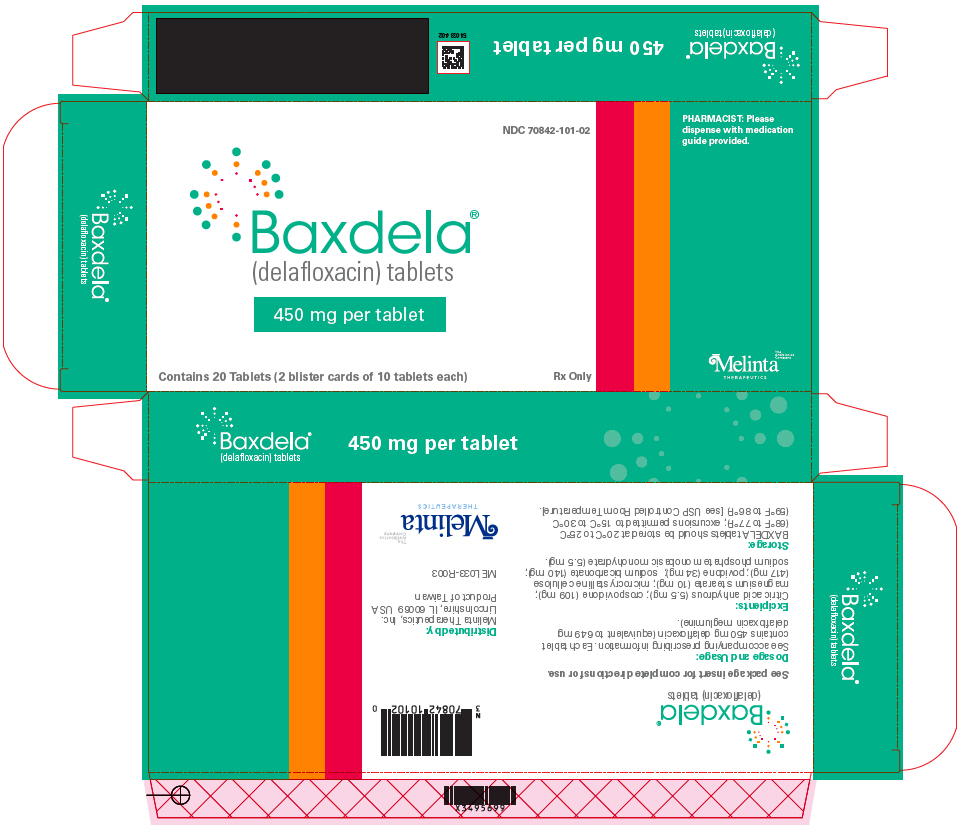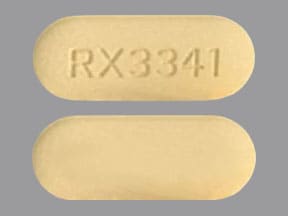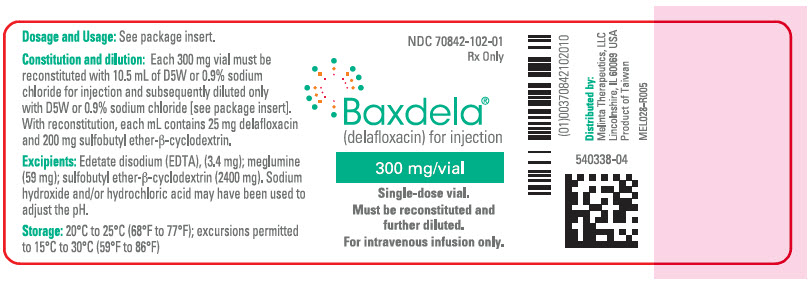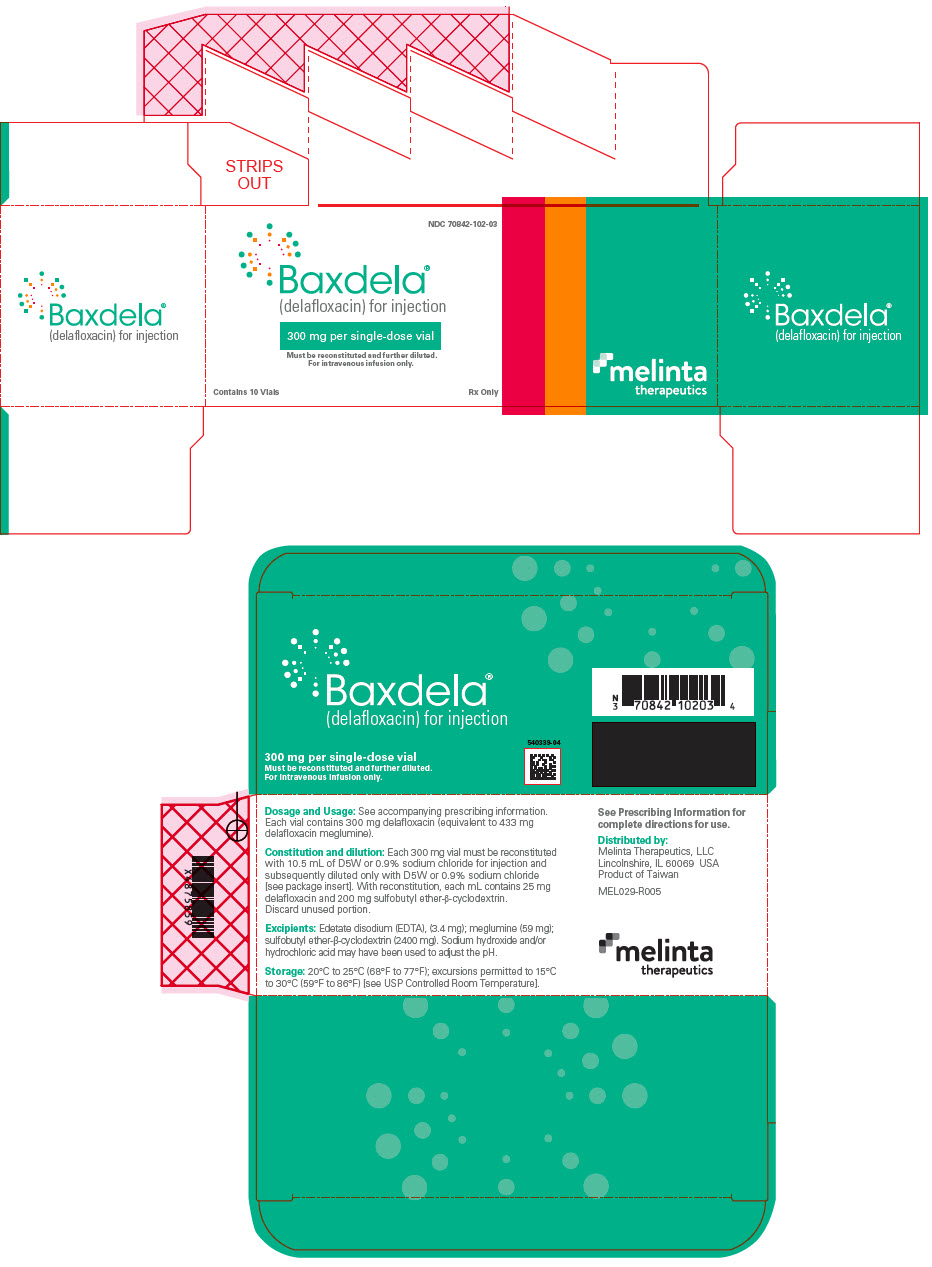Baxdela
Generic name: delafloxacin
What is Baxdela?
Baxdela is a fluoroquinolone antibacterial medicine used to treat certain types of infections caused by certain germs called bacteria in adults 18 years or older. These bacterial infections include:
- skin infections
- community-acquired bacterial pneumonia
It is not known if Baxdela is safe and effective in people under 18 years of age, and use in people under 18 years of age is not recommended. Children younger than 18 years of age may have a higher chance of getting bone, joint, and tendon (musculoskeletal) problems while taking fluoroquinolone antibacterial medicines.
Sometimes infections are caused by viruses rather than by bacteria. Examples include viral infections in the sinuses and lungs, such as the common cold or flu. Antibacterial medicines, including Baxdela, do not kill viruses. Call your healthcare provider if you think your condition is not getting better while you are taking Baxdela.
Description
BAXDELA (delafloxacin) for Injection and BAXDELA (delafloxacin) Tablets contain meglumine salt of delafloxacin, a fluoroquinolone antibacterial. Delafloxacin meglumine is identified chemically as 1-Deoxy-1-(methylamino)-D-glucitol, 1-(6-amino-3,5-difluoropyridin-2-yl)-8-chloro-6-fluoro-7-(3-hydroxyazetidin-1-yl)-4-oxo-1,4-dihydroquinoline-3-carboxylate (salt), the chemical structure of which is shown below. The meglumine salt has a molecular weight of 635.97 g/mol, whereas the molecular weight of the delafloxacin free acid is 440.76 g/mol.

BAXDELA is intended for intravenous infusion or oral administration. BAXDELA is supplied as a sterile, lyophilized powder for injection and oral tablets as follows:
What is the most important information I should know about Baxdela?
Baxdela, a fluoroquinolone antibacterial medicine, can cause serious side effects. Some of these serious side effects can happen at the same time and could result in death. If you get any of the following serious side effects while you take Baxdela, you should stop taking Baxdela immediately and get medical help right away.
1. Tendon rupture or swelling of the tendon (tendinitis).
- Tendon problems can happen in people of all ages who take Baxdela. Tendons are tough cords of tissue that connect muscles to bones. Symptoms of tendon problems may include:
- Pain, swelling, tears and inflammation of tendons including the back of the ankle (Achilles), shoulder, hand, or other tendon sites.
- The risk of getting tendon problems while you take Baxdela is higher if you:
- are over 60 years of age
- are taking steroids (corticosteroids)
- have had a kidney, heart or lung transplant
- Tendon problems can happen in people who do not have the above risk factors when they take Baxdela. Other reasons that can increase your risk of tendon problems can include:
- physical activity or exercise
- kidney failure
- tendon problems in the past, such as in people with rheumatoid arthritis (RA)
- Stop taking Baxdela immediately and call your healthcare provider right away at the first sign of tendon pain, swelling or inflammation. Stop taking Baxdela until tendinitis or tendon rupture has been ruled out by your healthcare provider. Avoid exercise and using the affected area. The most common area of pain and swelling is in the Achilles tendon at the back of your ankle. This can also happen with other tendons.
- Talk to your healthcare provider about the risk of tendon rupture with continued use of Baxdela. You may need a different antibacterial that is not a fluoroquinolone to treat your infection.
- Tendon rupture can happen while you are taking or after you have finished taking fluoroquinolone antibacterial medicines like Baxdela. Tendon ruptures can happen within hours or days of taking a fluoroquinolone and have happened up to several months after patients have finished taking their fluoroquinolone.
- Stop taking Baxdela immediately and get medical help right away if you get any of the following signs or symptoms of a tendon rupture:
- hear or feel a snap or pop in a tendon area
- bruising right after an injury in a tendon area
- unable to move the affected area or bear weight
2. Changes in sensation and possible nerve damage (Peripheral Neuropathy). Damage to the nerves in arms, hands, legs, or feet can happen in people who take fluoroquinolones, including Baxdela. Stop taking Baxdela immediately and talk to your healthcare provider right away if you get any of the following symptoms of peripheral neuropathy in your arms, hands, legs, or feet:
- pain
- burning
- tingling
- numbness
- weakness
Baxdela may need to be stopped to prevent permanent nerve damage.
3. Central Nervous System (CNS) effects. Seizures have been reported in people who take fluoroquinolone antibacterial medicines. Tell your healthcare provider if you have a history of seizures before you start taking Baxdela. CNS side effects may happen as soon as after taking the first dose of Baxdela. Stop taking Baxdela immediately and talk to your healthcare provider right away if you get any of these side effects, or other changes in mood or behavior:
- seizures
- hear voices, see things, or sense things that are not there (hallucinations)
- feel restless
- tremors
- feel anxious or nervous
- confusion
- depression
- trouble sleeping
- nightmares
- feel lightheaded or dizzy
- feel more suspicious (paranoia)
- suicidal thoughts or acts
- headaches that will not go away, with or without blurred vision
- memory problems
- false or strange thoughts or beliefs (delusions)
- difficulty paying attention
- reduced awareness of surroundings
4. Worsening of Myasthenia Gravis (a problem that causes muscle weakness). Fluoroquinolones like Baxdela may cause worsening of myasthenia gravis symptoms, including muscle weakness and breathing problems. Tell your healthcare provider if you have a history of myasthenia gravis before you start taking Baxdela. Call your healthcare provider right away if you have any worsening muscle weakness or breathing problems.
Who should not take Baxdela?
Do not take Baxdela if:
you have ever had a severe allergic reaction to an antibacterial known as a fluoroquinolone, or if you are allergic to any of the ingredients in Baxdela. Ask your healthcare provider if you are not sure. See the list of ingredients in Baxdela at the end of this Medication Guide.
What should I tell my healthcare provider before taking Baxdela?
See “What is the most important information I should know about Baxdela?”
Before you take Baxdela, tell your healthcare provider about all your medical conditions, including if you:
- have tendon problems. Baxdela should not be used in patients who have a history of tendon problems.
- have a disease that causes muscle weakness (myasthenia gravis). Baxdela should not be used in patients who have a history of myasthenia gravis.
- have central nervous system problems (such as epilepsy).
- have nerve problems. Baxdela should not be used in patients who have a history of a nerve problem called peripheral neuropathy.
- have a history of seizures.
- have kidney problems.
- have rheumatoid arthritis (RA) or other history of joint problems.
- have diabetes and take anti-diabetes medicines or insulin.
- are pregnant or planning to become pregnant. It is not known if Baxdela will harm your unborn child.
- are breast-feeding or planning to breastfeed. It is not known if Baxdela passes into human breast milk. You and your healthcare provider should decide whether you will take Baxdela or breast-feed.
Tell your healthcare provider about all the medicines you take, including prescription and over-the-counter medicines, vitamins and herbal and dietary supplements.
Baxdela and other medicines can affect each other causing side effects. Especially tell your healthcare provider if you take:
- A steroid medicine. Corticosteroids taken by mouth or by injection may increase the chance of tendon injury. See “What is the most important information I should know about Baxdela?”
- Certain medicines may keep Baxdela from working correctly. Baxdela Tablets should be taken at least 2 hours before or 6 hours after:
- an antacid, multivitamin, or other product that has magnesium, aluminum, iron, or zinc
- sucralfate
- didanosine buffered tablets for oral suspension or the pediatric powder for oral solution
Ask your healthcare provider if you are not sure if any of your medicines are listed above. Know the medicines you take. Keep a list of your medicines and show it to your healthcare provider and pharmacist when you get a new medicine.
How should I take Baxdela?
- Take Baxdela tablets 2 times a day exactly as your healthcare provider tells you to take it.
- If you have kidney problems, talk with your doctor about how you should take Baxdela.
- Baxdela can be taken with or without food.
- Baxdela IV is given to you by intravenous (IV) infusion into your vein slowly, over 60 minutes, as prescribed by your healthcare provider.
- Do not skip any doses, or stop taking Baxdela even if you begin to feel better, until you finish your prescribed treatment, unless you have:
- tendon problems, nerve problems, or central nervous system problems (see “What is the most important information I should know about Baxdela?”).
- a serious allergic reaction. (See “What are the possible side effects of Baxdela?”), or your healthcare provider tells you to stop.Unless you are experiencing any of the harmful side effects listed in this medication guide, take your Baxdela, as your healthcare provider tells you to take it, to help lower the chance that bacteria will become resistant to Baxdela. If this happens, Baxdela and other antibacterial medicines may not work in the future.
- If you miss a dose of Baxdela, take it as soon as you remember up to 8 hours before your next dose. If you have less than 8 hours before your next dose, wait to take your next dose at your regular time. Do not take more Baxdela to make up for the missed dose.
- If you take too much Baxdela, call your healthcare provider or get medical help immediately.
What should I avoid while taking Baxdela?
Baxdela can make you feel dizzy and lightheaded. Do not drive, operate machinery, or do other activities that require mental alertness or coordination until you know how Baxdela affects you.
What are the possible side effects of Baxdela?
Baxdela may cause serious side effects, including:
- See “What is the most important information I should know about Baxdela?”
- Serious allergic reactions. Serious allergic reactions, including death, can happen in people taking fluoroquinolones, including Baxdela, even after only 1 dose. Stop taking Baxdela and get emergency medical help right away if you get any of the following symptoms of a severe allergic reaction:
- hives
- swelling of the lips, tongue, face
- rapid heartbeat
- skin rash
- trouble breathing or swallowing
- throat tightness, hoarseness
- faint
Skin rash may happen in people taking fluoroquinolones even after only 1 dose. Stop taking Baxdela at the first sign of a skin rash and call your healthcare provider. Skin rash may be a sign of a more serious reaction to Baxdela.
- Clostridium difficile-associated diarrhea (CDAD). CDAD is an infection of your intestines (bowels) that can happen with many antibacterial medicines, including Baxdela, and may cause mild diarrhea to life-threatening swelling of your intestines (colitis). Call your healthcare provider right away if you get stomach cramps, fever, watery diarrhea, diarrhea that does not go away, or bloody stools. CDAD can happen 2 or more months after you have finished your antibacterial medicine.
- Aortic aneurysm and dissection. Tell your healthcare provider if you have ever been told that you have an aortic aneurysm, a swelling of the large artery that carries blood from the heart to the body. Get emergency medical help right away if you have sudden chest, stomach or back pain.
- Changes in blood sugar. People who take fluoroquinolone medicines with oral anti-diabetes medicines or with insulin can get low blood sugar (hypoglycemia) and high blood sugar (hyperglycemia). Follow your healthcare provider’s instructions for how often to check your blood sugar. If you have diabetes and you get low blood sugar while taking Baxdela, stop taking Baxdela and call your healthcare provider right away. Your antibiotic medicine may need to be changed.
The most common side effects of Baxdela include:
These are not all the possible side effects of Baxdela. Call your doctor for medical advice about side effects. You may report side effects to FDA at 1-800-FDA-1088.
Label
450 MG TABLET BLISTER PACK CARTON
- NDC 70842-101-02
- PHARMACIST: Please
dispense with medication
guide provided. - Baxdela®
(delafloxacin) tablets - 450 mg per tablet
- Contains 20 Tablets (2 blister cards of 10 tablets each)
- Rx Only
- Melinta
THERAPEUTICS - The Antibiotics Company


- NDC 70842-101-01
- Baxdela®
(delafloxacin) tablets - 450 mg per tablet
- Contains 20 Tablets
Rx Only - PHARMACIST: Please dispense
with medication guide provided. - melinta therapeutics

300 MG VIAL LABEL
- NDC 70842-102-01
Rx Only - Baxdela®
(delafloxacin) for injection - 300 mg/vial
- Single-dose vial.
Must be reconstituted and
further diluted.
For intravenous infuswn only.

- NDC 70842-102-03
- Baxdela®
(delafloxacin) for injection - 300 mg per single-dose vial
- Must be reconstituted and further diluted.
For intravenous infusion only. - Contains 10 Vials
Rx Only

General information about the safe and effective use of Baxdela
Medicines are sometimes prescribed for purposes other than those listed in a Medication Guide. Do not use Baxdela for a condition for which it was not prescribed. Do not give Baxdela to other people, even if they have the same symptoms that you have. It may harm them. You can ask your pharmacist or healthcare provider for information about Baxdela that is written for health professionals.
How should I store Baxdela?
Baxdela Tablets:
- Store Baxdela Tablets at room temperature between 68°F to 77°F (20°C to 25°C).
- Keep Baxdela away from moisture (humidity).
Keep Baxdela and all medicines out of the reach of children.
What are the ingredients in Baxdela?
Active ingredient: delafloxacin
Tablets inactive ingredients: Citric acid, Crospovidone, Magnesium stearate, Microcrystalline Cellulose, Povidone, Sodium bicarbonate, and Sodium phosphate monobasic, monohydrate.
For injection inactive ingredients: Meglumine, beta-cyclodextrin sulfobutyl ether, and EDTA
SRC: NLM .
